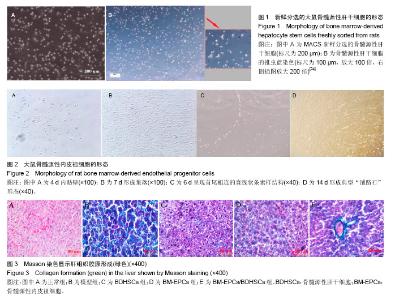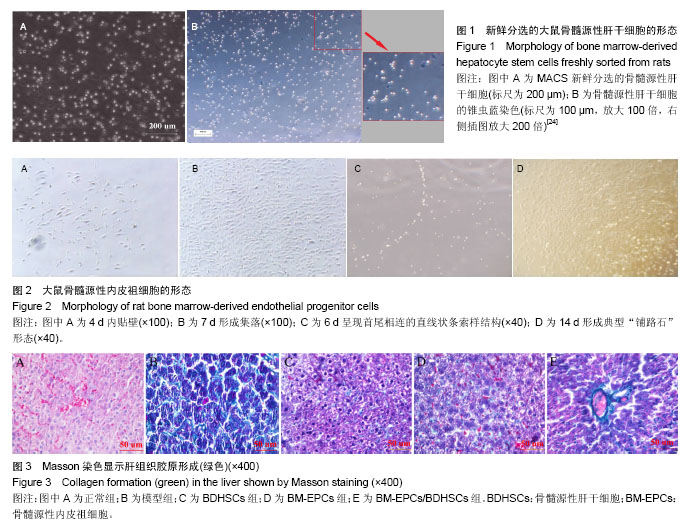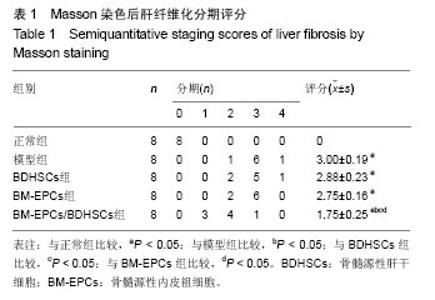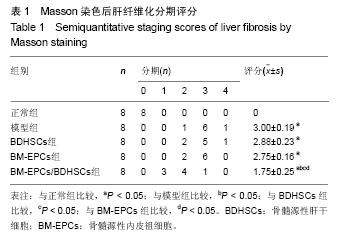| [1] Rautou PE. Endothelial progenitor cells in cirrhosis: the more, the merrier. J Hepatol. 2012;57(6):1163-1165.[2] Friedman SL. Mechanisms of hepatic fibrogenesis. Gastroenterology. 2008;134(6):1655-1669.[3] García-Bravo M, Morán-Jiménez MJ, Quintana-Bustamante O, et al. Bone marrow-derived cells promote liver regeneration in mice with erythropoietic protoporphyria. Transplantation. 2009;88(12):1332-1340.[4] Shackel N, Rockey D. In pursuit of the "Holy Grail"--stem cells, hepatic injury, fibrogenesis and repair. Hepatology. 2005; 41(1):16-18.[5] Russo FP, Alison MR, Bigger BW, et al. The bone marrow functionally contributes to liver fibrosis. Gastroenterology. 2006;130(6):1807-1821.[6] Nussler A, Konig S, Ott M, et al. Present status and perspectives of cell-based therapies for liver diseases. J Hepatol. 2006;45(1):144-159.[7] Oyagi S, Hirose M, Kojima M, et al. Therapeutic effect of transplanting HGF-treated bone marrow mesenchymal cells into CCl4-injured rats. J Hepatol. 2006;44(4):742-748.[8] Sakaida I, Terai S, Yamamoto N, et al. Transplantation of bone marrow cells reduces CCl4-induced liver fibrosis in mice. Hepatology. 2004;40(6):1304-1311.[9] Forbes SJ, Gupta S, Dhawan A. Cell therapy for liver disease: From liver transplantation to cell factory. J Hepatol. 2015;62(1 Suppl):S157-169.[10] Ishikawa T, Terai S, Urata Y, et al. Fibroblast growth factor 2 facilitates the differentiation of transplanted bone marrow cells into hepatocytes. Cell Tissue Res. 2006;323(2):221-231.[11] Lan L, Chen Y, Sun C, et al. Transplantation of bone marrow-derived hepatocyte stem cells transduced with adenovirus-mediated IL-10 gene reverses liver fibrosis in rats. Transpl Int. 2008;21(6):581-592.[12] Khoo CP, Pozzilli P, Alison MR. Endothelial progenitor cells and their potential therapeutic applications. Regen Med. 2008; 3(6):863-876.[13] Sakamoto M, Nakamura T, Torimura T, et al. Transplantation of endothelial progenitor cells ameliorates vascular dysfunction and portal hypertension in carbon tetrachloride-induced rat liver cirrhotic model. J Gastroenterol Hepatol. 2013;28(1):168-178.[14] Nakamura T, Torimura T, Sakamoto M, et al. Significance and therapeutic potential of endothelial progenitor cell transplantation in a cirrhotic liver rat model. Gastroenterology. 2007;133(1):91-107.[15] Lian J, Lu Y, Xu P, et al. Prevention of liver fibrosis by intrasplenic injection of high-density cultured bone marrow cells in a rat chronic liver injury model. PLoS One. 2014;9(9): e103603.[16] Nakamura T, Torimura T, Iwamoto H, et al. Prevention of liver fibrosis and liver reconstitution of DMN-treated rat liver by transplanted EPCs. Eur J Clin Invest. 2012;42(7):717-728.[17] Taniguchi E, Kin M, Torimura T, et al. Endothelial progenitor cell transplantation improves the survival following liver injury in mice. Gastroenterology. 2006;130(2):521-531.[18] Liu F, Liu ZD, Wu N, et al. Transplanted endothelial progenitor cells ameliorate carbon tetrachloride-induced liver cirrhosis in rats. Liver Transpl. 2009;15(9):1092-1100.[19] 周贤,刘翼,夏国栋,等.肝纤维化动物模型探讨[J].四川动物,2010, 29(1):114-119.[20] 刘冉,兰玲,于静,等.肝纤维化大鼠骨髓源性内皮祖细胞的培养及鉴定[J].基础医学与临床杂志,2011,31(12):1335-1340.[21] Avital I, Inderbitzin D, Aoki T, et al. Isolation, characterization, and transplantation of bone marrow-derived hepatocyte stem cells. Biochem Biophys Res Commun. 2001;288(1):156-164.[22] Inderbitzin D, Avital I, Gloor B, et al. Functional comparison of bone marrow-derived liver stem cells: selection strategy for cell-based therapy. J Gastrointest Surg. 2005;9(9): 1340-1345.[23] Wu XL, Zeng WZ, Wang PL, et al. Effect of compound rhodiola sachalinensis A Bor on CCl4-induced liver fibrosis in rats and its probable molecular mechanisms. World J Gastroenterol. 2003;9(7):1559-1562.[24] 兰玲,孙超,陈源文,等.大鼠β2m-/Thy-1+骨髓源性肝干细胞的体外分选及鉴定[J].上海交通大学学报:医学版,2007,27(11): 1293-1296.[25] 姚鹏,胡大荣,王帅,等.自体骨髓干细胞移植治疗慢性重症肝病临床研究[J].透析与人工器官,2006,17(1):18-21.[26] Thabut D, Shah V. Intrahepatic angiogenesis and sinusoidal remodeling in chronic liver disease: new targets for the treatment of portal hypertension. J Hepatol. 2010;53(5): 976-980.[27] Ueno T, Nakamura T, Torimura T, et al. Angiogenic cell therapy for hepatic fibrosis. Med Mol Morphol. 2006;39(1): 16-21.[28] Fadini GP, Losordo D, Dimmeler S. Critical reevaluation of endothelial progenitor cell phenotypes for therapeutic and diagnostic use. Circ Res. 2012;110(4):624-637.[29] Casamassimi A, Balestrieri ML, Fiorito C, et al. Comparison between total endothelial progenitor cell isolation versus enriched Cd133+ culture. J Biochem. 2007;141(4):503-511.[30] 曹葆强,林继宗,钟跃思,等.自体骨髓细胞经门静脉移植治疗肝硬化与肝功能不全的临床研究[J].中华普通外科杂志,2007, 22(5): 386-389.[31] Kushida T, Inaba M, Hisha H, et al. Crucial role of donor-derived stromal cells in successful treatment for intractable autoimmune diseases in mrl/lpr mice by bmt via portal vein. Stem Cells. 2001;19(3):226-235.[32] 兰玲,于静,刘冉,等.骨髓内皮祖细胞输注后在肝纤维化大鼠肝脏内的示踪研究[J].中华器官移植杂志,2012,33(11):684-688.[33] 刘冉,兰玲,刘博伟,等.来源于肝纤维化环境内皮祖细胞移植治疗肝纤维化模型大鼠的逆转作用[J].中国组织工程研究,2017, 21(13):2068-2073.[34] 王喜军,孙文军,孙晖,等.CCL4诱导大鼠肝损伤模型的代谢组学及茵陈蒿汤的干预作用研究[J].世界科学技术-中医药现代化, 2006,8(6):101-106.[35] 万智,安宁,朱易萍,等.丙氨酸转氨酶的研究现状与进展[J].华西医学,2010,25(1):238-240.[36] 刁建新,马文校, 刘亚伟,等.大鼠急性肝功能衰竭模型的建立及凝血功能的变化[J].世界科学技术-中医药现代化, 2014,16(11): 2406-2410. |





